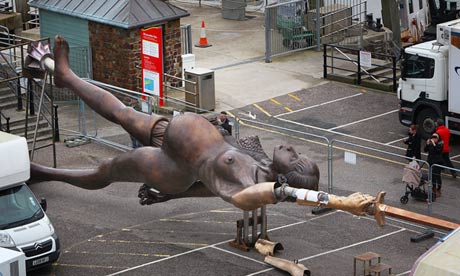The giant bronze woman holding up a sword in Devon not only resembles the art of totalitarian dictators, it is helping Hirst destroy British art
by Jonathan Jones

A while ago I suggested that Damien Hirst is like a deluded dictator. Maybe this seemed a trifle strong, an unnecessarily extreme analogy to describe Hirst's decay from lively young mind to arrogant purveyor of kitsch. But have you seen the giant statue he is raising at Ilfracombe in Devon?
I invoked dictators' artistic fantasies to suggest the level of badness and self-delusion in Hirst's figurative paintings, but the bronze woman of Ilfracombe invites a more direct comparison with the art of totalitarian regimes.
She will stand colossally over the harbour, holding up a sword that will spear into the sky. There is no subtlety to this oversized statue, and nothing avant garde, either. It is a banal image, cast in metal in a way that gives it an unjustified air of authority. It looks exactly like something you might have seen in Saddam Hussein's Iraq.
I have actually stood beneath a statue on this scale, and with this kind of pseudo-allegorical pretension: a vast monument in Russia that commemorates the Battle of Stalingrad. In fact, the resemblance is very close. Like Hirst's statue, the huge female figure that crowns the Stalingrad memorial holds a giant sword. To be fair to the creators of the Stalingrad statue, they were trying to mark one of the most epic battles in history. But the style they used is that of Stalin's propaganda art – vulgar, brazen, crass.
Hirst's statue in Devon revives the ugly vacuities of art in the age of the dictators. It really is a monstrosity.
So what now for British art? What does it mean that Hirst, who made British contemporary art famous in the 1990s, and who is still a huge popular draw as his show at Tate Modern proved, has turned out to be such an excruciatingly terrible artist?
Everyone except me seems to fall into one of two equally complacent camps on this. First, there are the people who hated Hirst all along, never saw anything there but fraud, and now feel cosily vindicated. But they are wrong: there is nothing clever about being closed off to the new, and Hirst, let's say from 1988 to 1995, was an unexpected, dazzling exponent of new ways to make art, who seemed driven by a real obsession with mortality.
Now, it is all turning to dust and misted formaldehyde.
I find the second form of complacency laughable. For many people who love contemporary art, there is simply no problem. Hirst is a faded light, sure – but that has no wider significance. British art today is replete with good, interesting artists in all media whose diverse creativity makes the commercial age of Hirst seem a long time ago. We've moved on.
Rubbish. That's like saying there were lots of artists in late 1960s New York who made Andy Warhol look old-fashioned. In retrospect, it is Warhol who defined the American art of his age, full stop. Hirst dominates British art in our time. He is the most successful British artist ever. He has taken the commercial logic of pop to levels undared by Warhol or even Jeff Koons. When histories of modern Britain come to be written by later generations, it will be Hirst whose art shapes the image of these times.
Hirst invented the "young British art" generation when he curated the exhibition Freeze. Most were minnows in his wake.
We will be judged by him. He made modern British art, and he has destroyed it. Don't you understand? This time is going to be remembered as what Hirst is making it, with his bronze statues and hideous daubs – a dark age for British art.
No comments:
Post a Comment